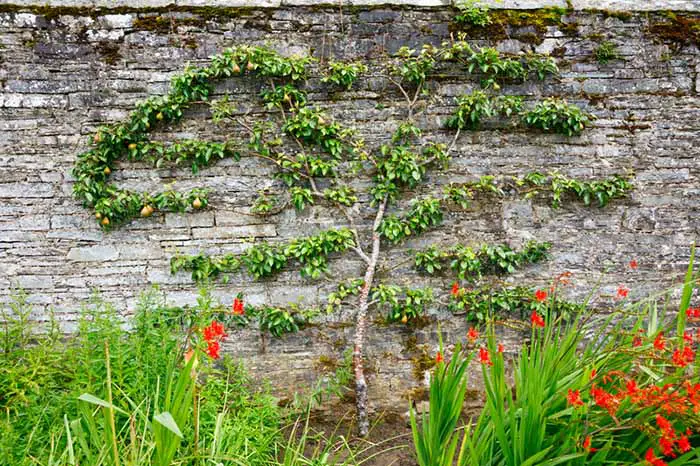
One of the best things about espalier fruit trees is that you can make room for one in just about any garden. All you need is a few feet of space, sunlight, and time.
Espalier is the art of training a tree into a particular flat shape. They are often placed against a wall, a fence, or supported by a freestanding trellis. Espalier allows more fruit to grow in a small space – perfect for a backyard Fruit Grove or urban garden.
But before you take the leap to start your own espalier fruit tree, there are a few things to know first. Read on to learn some of the advantages and challenges of espalier and what to expect from your tree. Growing your own fruit in limited space is worth it.
Check out the video below to see how I started my own backyard apple espalier:
1. Be patient – expect it to take time.
The care you put in now to choose a spot, set up a support trellis, train, prune – and prune some more – will pay off in the long run. For the first few years, your goal is to help the tree establish the espalier shape and develop a healthy root system. In most cases, this means actually removing young fruit from the tree so it can put its energy to growing branches and roots.
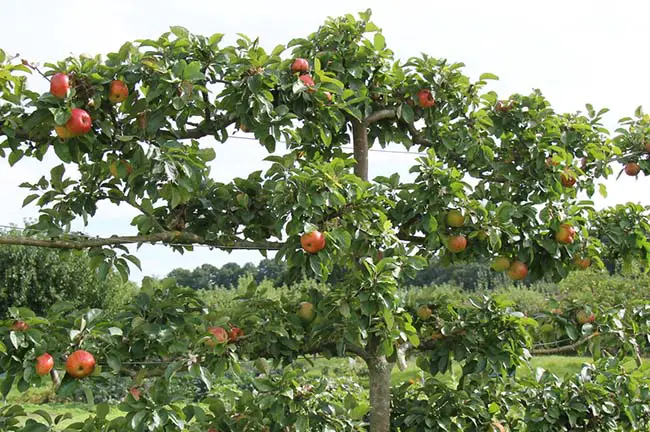
It may take 3 – 5 years (or more) before you see a full crop of fruit. But once fruiting begins, that small tree will produce more fruit than you know what to do with. Espalier is a long game that takes patience and persistence. But isn’t that the beauty of it?
2. Location is key.
Before you start on a several-year journey of starting and maintaining an espalier fruit tree, take the time to scope out the perfect location. Most fruit trees need full sun (at least 6 to 8 hours a day) and well-drained soil.
For espalier, choose a sunny location next to a wall or fence. Most espalier designs need at least 7 feet of linear space from end to end. You can also provide sturdy posts and wires to support a freestanding espalier, which can also function as a fence.
3. It’s best to start a new espalier in early spring.
Plant a new espalier at the very beginning of the growing season in early spring. This gives it a chance to establish itself in the landscape as it grows to fill the espalier shape. Once the tree begins to grow, it will be easy to see which branches to train along the trellis and which to prune away.
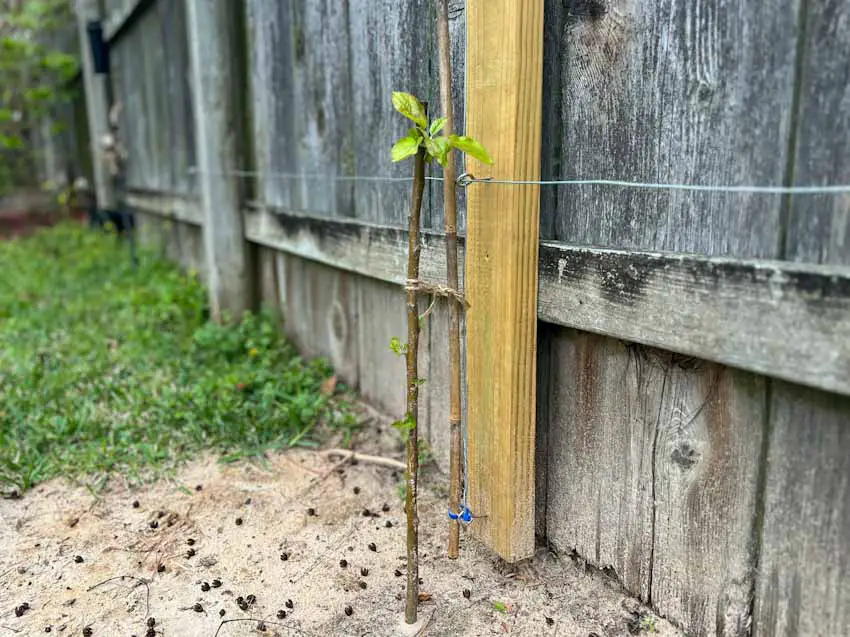
4. Pick the right kind of tree.
Apples and pears are the most common fruits used for espalier, but you can also use quince, figs, citrus, peaches, nectarines, plums, apricots, pomegranates, persimmons, or cherries.
Certain of these fruits, such as cherries, are more difficult to espalier than others, due to the way they grow and produce fruit. Spur-bearing apple and pear trees are generally the easiest for beginners since they produce fruit on stubby shoots along the lateral branches.
Learn more: 50 Apple Varieties for Espalier: How to Choose the Right One
Different fruit trees tend to prefer different espalier shapes. For example, citrus and stone fruit trees grow best in a fan shape, while apple trees can be trained into almost any pattern.
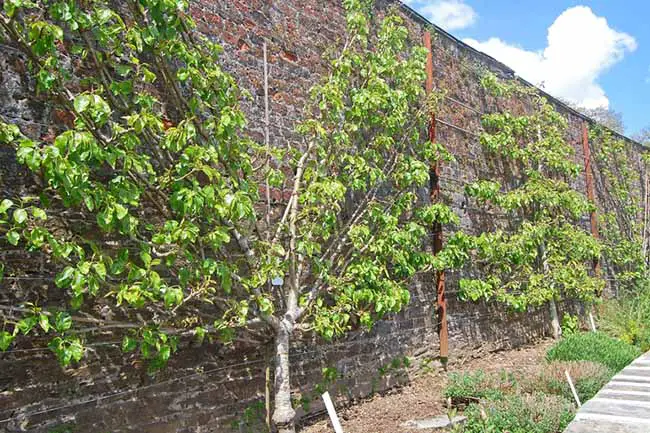
When starting an espalier, choose a young tree (1 to 2 years old) with a slender central trunk and few branches. Even better – use an unbranched whip (available at specialty nurseries or online).
Bare-root trees will have an easier time establishing in the landscape but must be planted right away. A potted tree can stay in its container for a while, buying some time before you need to get it in the ground. But you may need to take extra care to help the tree settle into its new spot in your garden.
5. You might need more than one tree.
Many fruit trees are self-fertile, but some require another tree of the same species for pollination. For example, most apple trees require pollination by another apple variety. Even self-fertile trees often produce a better crop of fruit when a pollinizer is grown nearby, as is the case with many fig varieties.
Double check your tree choice – you might need to make room for a second espalier. But that also means twice the fruit!
6. You’ll be pruning – a lot.
The first cut is the hardest – in most cases, the first pruning you’ll do is topping the central trunk to the right height to encourage lateral branches to grow. Then you’ll be pruning the unnecessary vigorous shoots so the side branches continue to lengthen and fill the trellis. All summer long, you’ll keep making adjustments and removing unwanted growth. And the next year it starts all over again.
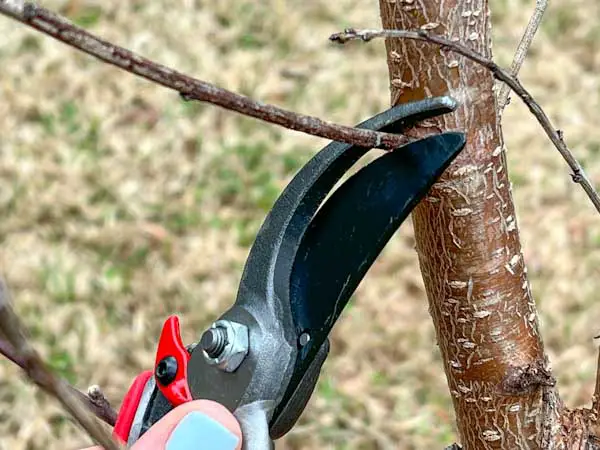
But don’t let that be intimidating! The goal is essentially to keep the tree growing in the direction you want, and to remove anything extra. It’s exciting to have such a hand in helping the tree grow and develop. And, like so many things in gardening, there’s more than one right way to prune. Just keep your pruning shears handy, clean, and sharp so you’re always at the ready.
7. Expect less disease pressure.
One of the big advantages to espalier is that by limiting a tree’s growth, each individual branch and fruit gets better air circulation. Every time it rains, the branches and leaves will be able to dry off quicker. This means less susceptibility to disease and pest problems.
8. The fruit will be bigger and better.
Just as an espalier tree has better air circulation, it has better access to sunlight, too. Since the branches are spread out, each leaf and fruit will be exposed to more direct light.
Limiting the tree’s growth also means that it has more resources to put to fruiting, rather than supporting a large leafy canopy. The fruit will grow larger and develop more sugar and overall better flavor.
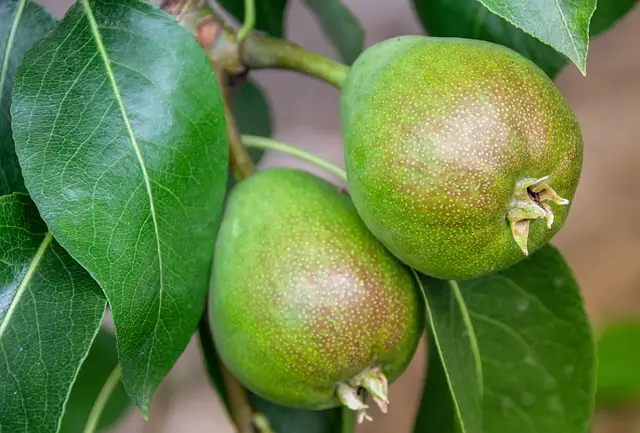
9. Harvesting will be much easier.
This may not seem like a big deal now, but fast forward a few years. It’s much easier to pick fruit from a 7-foot apple tree than a 30-foot apple tree. Yet another advantage to espalier – they can be trained to any height.
Most espaliers are designed to be about 6-8 feet tall and wide. That keeps the fruit within arm’s reach at all times – no ladders necessary.
10. You’ll learn a lot the first couple of years.
Starting an espalier fruit tree for the first time is quite a leap to take. If you’re like me, you may even find there are a few things you wish you’d done differently – but that’s ok. My attitude is: do research, make a plan. But at some point you just have to go for it, knowing that there’s still a lot to learn.

